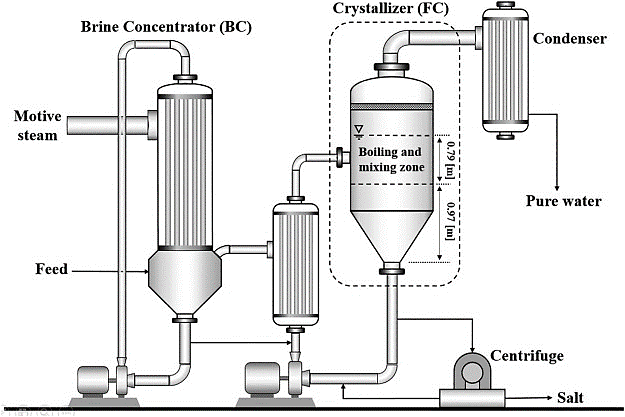
Crystallization is a physical change. Crystallization is the formation of solids from the liquid or gaseous phase. This technique includes obtaining the crystals of a soluble substance from a hot saturated solution and separating the soluble solid from the solution.
To concentrate feed into solid crystals and clean water, crystallizers are used. A progressively harder method for which crystallite sizes are formed from a liquid solution is known as crystallization. Crystallizers can remove liquid wastes completely, resulting in no liquid discharge (ZLD). The process continues and secondary crystallization are the two stages of crystallization. The formation of new crystals is referred to as primary nucleation. Secondary nucleation is the primary stage that results in the mass production of crystals. There are two types of crystallization processes: evaporative crystallization and cooling crystallization.
Despite the fact that crystallization procedures is usually tough to regulate, sonocrystallization is a more recent kind of crystallization which has several strengths more than preceding techniques. The event, expansion, and collapse of bubbles are recognised to induce acoustic cavitation in liquids.
Some pre-treatment method processes, such as acidification accompanied by degasification release an quantity of CO2 into the environment.
The dense salt crust surface layer together with the salt crystals filling inside the QGF membrane in the situation from the concentrated SWRO brine causes the failure of your 3D crystallizer for the duration of the long run operations.
To understand the drinking water transportation as well as the ion focus distribution over the operation with the crystallizer, the salt ion distribution inside the crystallizer was simulated. The profile structure with the crystallizers was simulated making use of COMSOL Multiphysics software program. The effects in the h2o transport simulation are demonstrated in Determine 8a. It is clear the brine was immediately transported through the h2o transport layer to your photothermal layer. In the course of brine transportation, brine backflow and diffusion occurred concurrently. Given that the inclusion angle among the photothermal levels turned larger, the diffusion result of brine grew to become much better in the intersection on the photothermal layer and the water transport layer.
The website is protected. The https:// makes certain that you're connecting to the Formal Web site Which any details you provide is encrypted and transmitted securely.
Getting motivated because of the salt dilution and salt secretion mechanism of halophyte, Zhang et al. [27] ready an evaporator able to surface salt secretion and edge salt dilution utilizing glass fiber felt and Polypyrrole (PPy). Sun et al. [28] 3D-printed conical PLA buildings with concave grooves by mimicking mussel seashells and afterwards coated the top layer with the evaporator with PPy to appreciate freshwater assortment.
Therefore, the NaCl salt crust tends to expansion along the out-of-airplane way to progressively improve its thickness and to maintain its porosity fairly reliable. The porosity on the salt crust formed by pure NaCl brine (20 wt%) is 19.three% based on mercury intrusion porosimetry measurement. As illustrated in Fig. 5a, the loosely packed pure NaCl salt crust layer permits liquid water and h2o vapor transport, which explains the secure drinking water evaporation overall performance with pure NaCl brine.
Concurrently, the suppressed evaporation with the real seawater brines results in a Considerably scaled-down negative temperature gradient in the outer to inner side on the QGF membrane in addition to a decreased water flux from the inner facet of the QGF membrane to its outer facet, which Gains the salt ions back again diffusion into the interior aspect. Due to this fact, the internal side from the QGF membrane possesses the comparable temperature and salt concentration into the outer area, and therefore promotes salt precipitation In the membrane, compared with the situation of pure NaCl brine.
The authors declare that the information supporting the results of this research are available from the authors on ask for.
Observe: In Fig. 3c, an optional transparent polycarbonate protect that has a top of thirty mm was additional to the photo voltaic crystallizer as a way to stop salt crystal from creeping into your internal facet on the crystallizer.
Sublimation: It isn’t the best way to make diffraction-top quality crystals. Normally performed at high temperatures, which leads to crystals to develop much too quick.
To resolve this issue, a salt crystallization inhibition approach involving adding NTA into authentic SWRO was then proposed. The NTA can make cubic NaCl crystal turn out to be dendritic-shaped46. Predictably, it will eventually direct the development of a remarkably porous aggregation layer within the outer area of QGF membrane.
3d. It Evidently reveals the internal side from the QGF membrane was fairly clean with negligible Crystallizer Manufacturer Crystallizer For Zero Liquid Discharge System salt crystals noticed. The clean up internal side as well as the thick salt crust layer within the outer surface can be stated as follows.
To ascertain the reason at the rear of the pretty contrasting drinking water evaporation behaviors, a 2D silica/carbon/silica tri-layered coaxial fibrous membrane disk (second SCS disk)38 plus a 3D graphene oxide/multiwalled carbon nanotube coated cellulose membrane film (3D GO/MWCNT movie)20 were being fabricated based on the literatures and employed as photo voltaic crystallizers. The significant decrease during the drinking water evaporation rates was also observed on both of these units within two h when treating the concentrated SWRO brine (Fig.